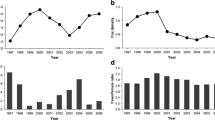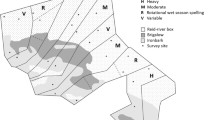Abstract
The effects of vertebrate predation have been monitored since 1989 on 16 replicated 0.56 ha study plots in a semiarid thorn scrub community in north-central Chile. Using fences of different heights with and without holes and suspended game netting to alter principal predator (foxes and raptors) and large rodent herbivore (Octodon degus) access, four grids each have been assigned to the following treatments: 1) low fencing and holes allowing free access of predators and small mammals; 2) low fencing without holes to exclude degus only; 3) high fencing and netting with holes to exclude predators only; and 4) high fencing and netting without holes to exclude predators and degus. Small mammal population censuses are conducted monthly using mark-recapture techniques. Degu population trends during 1989 and 1990 showed strongly but nonsignificantly lower numbers in control plots during months when densities were characteristically low (September–November) for this seasonally reproductive species; since March 1991, differences have become persistent and increasingly significant. Predators appear to have greater numerical effects when their prey populations are low. Survival times of degus, particularly established adults, were significantly longer in predator exclusion grids during the 2 1/2 years of observation; thus, predation also affects prey population structure.
Similar content being viewed by others
References
Akçakaya HR (1992) Population cycles of mammals: evidence for a ratio-dependent predation hypothesis. Ecol Monogr 62:119–142
Ambrose HW (1972) Effect of habitat familiarity and toe-clipping on rate of owl predation in Microtus pennsylvanicus. J Mammal 53:909–912
Brown JS (1989) Desert rodent community structure: a test of four mechanisms of coexistence. Ecol Monogr 59:1–20
Brown JH, Munger JC (1985) Experimental manipulation of a desert community: food addition and species removal. Ecology 66:1545–1563
Brown JH, Davidson DW, Munger JC, Inouye RS (1986) Experimental community ecoalogy: the desert granivore system. In: Diamond J, Case TJ (eds) Community ecology. Harper & Row, New York, pp 41–61
Brown JS, Kotler BP, Smith RJ, Wirtz II WO (1988) The effects of owl predation on the foraging behavior of heteromyid rodents. Oecologia 76:408–415
Desy EA, Batzli GO (1989) Effects of food availability and predation on prairie vole demography: a field experiment. Ecology 70:411–421
Desy EA, Batzli GO, Liu J (1990) Effects of food and predation on behaviour of prairie voles: a field experiment. Oikos 58:159–168
Dice LR (1947) Effectiveness of selection by owls of deer mice (Peromyscus maniculatus) which contrast with their color background. Contrib Lab Vert Biol, Univ Michigan 34:1–20
Erlinge S, Göransson G, Hansson L, Högstedt G, Liberg O, Nilsson IN, Nilsson T, von Schantz T, Sylvén M (1983) Predation as a regulating factor on small rodent populations in southern Sweden. Oikos 40:36–52
Erlinge S, Göransson G, Högstedt G, Jansson G, Liberg O, Loman J, Nilsson IN, von Schantz T, Sylvén M (1984) Can vertebrate predators regulate their prey? Am Nat 123:125–133
Erlinge S, Göransson G, Högstedt G, Jansson G, Liberg O, Loman J, Nilsson IN, von Schantz T, Sylvén M (1988) More thoughts on vertebrate predator regulation of prey. Am Nat 132:148–154
Fitzgerald BM (1977) Weasel predation on a cyclic population of the montane vole (Microtus montanus) in California. J Anim Ecol 46:367–397
Fulk GW (1975) Population ecology of rodents in the semiarid shrublands to Chile. Occas Papers Mus Texas Tech Univ 33:1–40
Fulk GW (1976a) Owl predation and rodent mortality: a case study. Mammalia 40:423–427
Fulk GW (1976b) Notes on the activity, reproduction, and social behavior of Octodon degus. J Mammal 57:495–505
Glanz WE (1977) Comparative ecology of small mammal communities in California and Chile. Ph.D. thesis, University of California, Berkeley. 300 pp
Glanz WE, Meserve PL (1982) An ecological comparison of small mammal communities in California and Chile. In: Conrad CE, Oechel WC (eds) Dynamics and management of Mediteranean type ecosystems. U.S. Forest Service, Pacific Southwest Forest Range Experiment Station, Gen Tech Rep PSW-58, pp 220–226
Hairston NG, Smith FE, Slobodkin KB (1960) Community structure, population control, and competition. Am Nat 94:421–425
Hanski I, Hansson L, Henttonen H (1991) Specialist predators, generalist predators, and the microtine rodent cycle. J Anim Ecol 60:353–367
Hoffmann A (1989) Flora silvestre de Chile: zona central. 2nd. ed. Ediciones Fundacion Claudio Gay, Santiago, Chile
Iriarte JA, Contreras LC, Jaksic FM (1989) A long-term study of a small-mammal assemblage in the central Chilean matorral. J Mammal 70:79–87
Jaksic FM (1986) Predation upon small mammals in shrublands and grasslands of southern South America: ecological correlates and presumable consequences. Rev Chil Hist Nat 59:209–221
Jaksic FM (1987) Overview of South American research on interactions between trophic levels. Rev Chil Hist Nat 60:363–366
Jaksic FM, Ostfeld RS (1983) Numerical and behavioral estimates of predation upon rabbits in mediterranean-type shrublands: a paradoxical case. Rev Chil Hist Nat 56:39–49
Jaksic FM, Simonetti JA (1987) Predator/prey relationships among terrestrial vertebrates: an exhaustive review of studies conducted in southern South America. Rev Chil Hist Nat 60:221–244
Jaksic FM, Fuentes ER, Yáñez JL (1979) Spatial distribution of the Old World rabbit (Oryctolagus cuniculus) in central Chile. J Mammal 60:207–209
Jaksic FM, Greene HW, Yáñez JL (1981) The guild structure of a community of predatory vertebrates in central Chile. Oecologia 49:21–28
Jaksic FM, Jiménez JE, Castro SA, Feinsinger P (1992) Numerical and functional response of predators to a long-term decline in mammalian prey at a semi-arid Neotropical site. Oecologia 89:90–101
Jaksic FM, Meserve PL, Gutiérrez JR, Tabilo E (1993) The components of predation on small mammals in north-central Chile: preliminary results. Rev Chil Hist Nat 66
Jiménez JE, Feinsinger P, Jaksic FM (1992) Spatiotemporal patterns of an irruption and decline of small mammals in northcentral Chile. J Mammal 73:356–364
Keith LB, Cary JR, Rongstad OJ, Brittingham M (1984) Demography and ecology of a declining snowshoe hare population. Wildl Monogr 90:1–43
Kerfoot WC, Sih A (1987) Predation. Univ Press of New England, Hanover, New Hampshire
Kotler BP (1984a) Harvesting rates and predatory risk in desert rodents: a comparison of two communities on different continents. J Mammal 65:91–96
Kotler BP (1984b) Risk of predation and the structure of desert rodent communities. Ecology 65:689–701
Kotler BP (1984c) Effects of illumination on the rate of resource harvesting in a community of desert rodents. Am Midld Nat 112:383–389
Kotler BP, Brown JS, Hasson O (1991) Factors affecting gerbil foraging behavior and rates of owl predation. Ecology 72:2249–2260
Kotler BP, Brown JS, Smith RJ, Wirtz II WO (1988) The effects of morphology and body size on rates of owl predation on deser rodents. Oikos 53:145–152
Le Boulengé ER (1985) Computer package for the analysis of capture-recapture data. Acta Zool Fennica 173:69–72
Lee ET (1980) Statistical methods for survival data analysis. Lifetime Learning Publications, Belmont, California
Lidicker WZ Jr (1973) Regulation of numbers in an island population of the California vole, a problem in community dynamics. Ecol Monogr 43:271–302
Longland WS, Price MV (1991) Direct observation of owls and heteromyid rodents: can predation risk explain microhabitat use? Ecology 72:2261–2273
Marcström V, Kenward RE, Engren E (1988) The impact of predation on boreal tetraonids during vole cycles: an experimental study. J Anim Ecol 57:859–872
Marcström V, Keith LB, Engren E, Cary JR (1989) Demographic responses of arctic hares (Lepus timidus) to experimental reductions of red foxes (Vulpes vulpes) and martens (Martes martes). Can J Zool 67:658–668
Marti CD, Hogue JG (1979) Selection of prey by size in screech owls. Auk 96:319–327
Menge JL, Sutherland JP (1976) Species diversity gradients: synthesis of the roles of predation, competition, and temporal heterogeneity. Am Nat 110:351–369
Meserve PL (1981a) Resource partitioning in a Chilean semi-arid small mammal community. J Anim Ecol 50:745–757
Meserve PL (1981b) Trophic relationships among small mammals in a Chilean semiarid thorn scrub community. J Mammal 62:304–314
Meserve PL, Le Boulengé ER (1987) Population dynamics and ecology of small mammals in the northern Chilean semiarid region. In: Patterson BD, Timm RM (eds) Studies in Neotropical mammalogy: Essays in honor of Philip Hershkovitz. Fieldiana: Zoology, new ser. 39:413–431
Meserve PL, Martin RE, Rodríguez J (1984) Comparative ecology of the caviomorph rodent Octodon degus in two Chilean mediterranean-type communities. Rev Chil Hist Nat 57:79–89
Meserve PL, Shadrick EJ, Kelt DA (1987) Diets and selectivity of two Chilean predators in the northern semi-arid zone. Rev Chil Hist Nat 60:93–99
Meserve PL, Gutiérrez JR, Contreras LC, Jaksic FM (1993) Role of biotic interactions in a semiarid scrub community in north-central Chile: a long-term ecological experiment. Rev Chil Hist Nat 66
Munger JC, Brown JH (1981) Competition in desert rodents: an experiment with semipermeable enclosures. Science 211:510–512
Muñóz M (1985) Flores del Norte Chico. Dirección de Bibliotecas, Municipalidad de La Serena, La Serena, Chile
Muñóz C, Pisano E (1947) Estudio de la vegetación y flora de los parques nacionales de Fray Jorge y Talinay. Agricult Tecn (Chile) 2:71–190
Murúa R, Meserve PL, González LA, Jofré C (1987) The small mammal community of a Chilean temperate rain forest: lack of evidence of competition between dominant species. J Mammal 68:729–738
Newsome AE, Parer I, Catling PC (1989) Prolonged prey suppression by carnivores-predator-removal experiments. Oecologia 78:458–467
Pearson OP (1964) Carnivore-mouse predation: an example of its intensity and bioenergetics. J Mammal 45:177–188
Pearson OP (1966) The prey of carnivores during one cycle of mouse abundance. J Anim Ecol 35:217–233
Pearson OP (1971) Additional measurements of the impact of carnivores on California voles (Microtus californicus). J Mammal 52:41–49
Pearson OP (1985) Predation. In: Tamarin RH (ed) Biology of New World Microtus. (Special Publication 8) American Society Mammalogists, Lawrence, Kansas, pp 535–566
Pech RP, Sinclair ARE, Newsome AE, Catling PC (1992) Limits to predator regulation of rabbits in Australia: evidence from predator-removal experiments. Oecologia 89:102–112
Schoener TW (1986a) Overview: kinds of ecological communities-ecology becomes pluralistic. In: Diamond J, Case TJ (eds) Community ecology. Harper & Row, New York, pp 467–479
Schoener TW (1986b) Patterns in terrestrial vertebrate versus arthropod communities: do systematic differences in regularity exist? In: Diamond J, Case TJ (eds) Community ecology. Harper & Row, New York, pp 556–586
Schoener TW (1989) Food webs from the small to the large. Ecology 70:1559–1589
Sih A, Crowley P, McPeek M, Petranka J, Strohmeier K (1985) Predation, competition, and prey communities: a review of field experiments. Annu Rev Ecol Syst 16:269–311
Simonetti JA (1989a) Microhabitat use by small mammals in central Chile. Oikos 56:309–318
Simonetti JA (1989b) Microhabitat use by Oryctolagus cuniculus in central Chile: a reassessment. Mammalia 53:363–368
Sinclair ARE, Olsen PD, Redhead TD (1990) Can predators regulate small mammal populations? Evidence from house mouse outbreaks in Australia. Oikos 59:382–392
Steel RGD, Torrie JH (1980) Principles and procedures of statistics. A biometrical approach. 2nd. ed. McGraw-Hill, New York
Thompson SD (1982a) Microhabitat utilization and foraging behavior of bipedal and quadrupedal heteromyid rodents. Ecology 63:1303–1312
Thompson SD (1982b) Structure and species composition of desert heteromyid rodent species assemblages: effects of a simple habitat manipulation. Ecology 63:1313–1321
Yáñez JL, Jaksic FM (1978) Historia natural de Octodon degus (Molina) (Rodentia, Octodontidae). Publicac Ocas, Museo Nac Hist Nat (Chile) 27:1–11
Author information
Authors and Affiliations
Rights and permissions
About this article
Cite this article
Meserve, P.L., Gutiérrez, J.R. & Jaksic, F.M. Effects of vertebrate predation on a caviomorph rodent, the degu (Octodon degus), in a semiarid thorn scrub community in Chile. Oecologia 94, 153–158 (1993). https://doi.org/10.1007/BF00341311
Received:
Accepted:
Issue Date:
DOI: https://doi.org/10.1007/BF00341311




